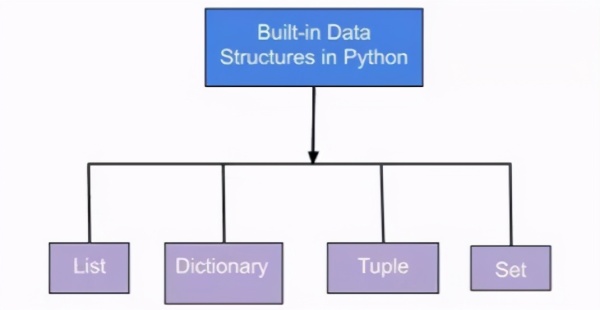本文转载自公众号“读芯术”(ID:AI_Discovery)。
Python可谓是如今最流行的编程语言,甚至孩子们也可以从它开始学习趣味编程。Python类似英语的简单语法使它成为一种通用语言,已在全世界各个领域被广泛使用。
Python的万能之处正在于其内置的数据结构,它使编码变得简单,不受数据类型限制,并可以根据需要操纵数据。

首先,让我们试着理解什么是数据结构?数据结构是能够存储、组织和管理数据的结构/容器,以便能够有效地访问和使用数据。数据结构就是收集数据类型。Python中有四种内置数据结构。它们是:
- 列表
- 字典
- 元组
- 集合

开发人员最常用的数据结构是列表和字典。接下来,让我们详细看看每一个数据结构。
1. 列表
Python列表是按顺序排列的任意类型的项的集合。一个列表可以有重复的项,因为每个项都是使用索引访问的,而且可以通过使用负索引逆向访问该列项。列表是可变的,这意味着即使在创建了项之后,也可以添加、删除或更改项;一个列表中还可以包含另一个列表。
(1) 创建列表:
列表可以通过将元素括在[ ]方括号中来创建,每个项之间用逗号分隔。以购物清单为例,创建列表的语法是:
- #Creating a list fruits = ['Apple', 'Banana', "Orange"]
- print(type(fruits)) #returns type
- print(fruits) #prints the elements of the listOutput:
- <class 'list'>
- ['Apple', 'Banana', 'Orange']
(2) 访问列表:
可以使用索引访问列表中的项。列表中的每个项都有一个与之关联的索引,具体取决于该项在列表中的位置。访问列表中的项的语法:
- #Access elements in the fruits listfruits = ['Apple', 'Banana',"Orange"]
- print(fruits[0]) #index 0 is the first element
- print(fruits[1])
- print(fruits[2])Output:
- Apple
- Banana
- Orange
但是,索引不必总是为正。如果想逆向访问列表,也就是按照相反的顺序,可以使用负索引,如下所示:
- #Access elements in the fruits list using negative indexesfruits = ['Apple','Banana', "Orange"]
- print(fruits[-1]) #index -1 is the last element
- print(fruits[-2])
- print(fruits[-3])Output:
- Orange
- Banana
- Apple
如果必须返回列表中两个位置之间的元素,则使用切片。必须指定起始索引和结束索引来从列表中获取元素的范围。语法是List_name[起始:结束:步长]。在这里,步长是增量值,默认为1。
- #Accessing range of elements using slicingfruits = ['Apple', 'Banana',"Orange"]
- fruits #all elements
- ['Apple', 'Guava', 'Banana', 'Kiwi'] #output
- fruits[::1] #start to end with step 1
- ['Apple', 'Guava', 'Banana', 'Kiwi'] #outputfruits[::2] #start to endwith step 2 basically index 0 & 2
- ['Apple', 'Banana'] #output
- fruits[::3] #start to end with step 2 basically index 0 & 3
- ['Apple', 'Kiwi'] #output
- fruits[::-1] #start to end with step 2 - reverse order
- ['Kiwi', 'Banana', 'Guava', 'Apple'] #output
(3) 向列表中添加元素:
可以使用append()、extend()和insert()函数向列表添加项。
- #Adding elementsfruits = ['Apple', 'Banana', "Orange"]#Appendnew elements
- fruits.append('Kiwi')
- print(fruits)
- Output:
- ['Apple', 'Banana', 'Orange', 'Kiwi']#Insertelements in to the listfruits.insert(1,'Guava') #inserts Guava as secondelement is the list since the index is specified as 1
- print(fruits)
- Output:
- ['Apple', 'Guava', 'Banana','Orange', 'Kiwi']
(4) 从列表中删除项:
与添加元素类似,从列表中删除元素也非常容易,可以使用del()、remove()和pop()方法实现。要清除整个列表,可以使用clear()函数。
- del()函数删除给定索引处的元素。
- pop()函数从列表中删除给定索引处的元素,也可以将删除的元素赋值给变量。如果未指定索引值,则删除列表中的最后一个元素。
- remove()函数根据元素的值来删除元素。
- clear()函数清空列表。
- #Deleting elements from the listfruits = ['Apple', 'Guava', 'Banana','Orange', 'Kiwi']
- #del() function
- del fruits[3] #delete element at index 4
- print(fruits)
- Output:
- ['Apple', 'Guava', 'Banana', 'Kiwi']#pop()function
- del_fruit = fruits.pop(2)
- print(del_fruit)
- print(fruits)
- Output:
- 'Banana'
- ['Apple', 'Guava', 'Orange', 'Kiwi']
- #Remove function
- fruits.remove('Apple')
- print(fruits)
- Output:
- ['Guava', 'Banana', 'Orange', 'Kiwi']
- #Clear() function
- fruits.clear()
- print(fruits)
- Output :
- [] # clears the list
其他函数:
在处理列表时,还可以使用其他几个函数:
- len()函数返回列表的长度。
- index()函数查找第一次遇到的传入值的索引值。
- count()函数查找传递给它的值的个数。
- sorted()和sort()函数用于对列表的值进行排序。sorted()具有返回类型,而sort()修改原始列表。
- #Other functions for listnum_list = [1, 2, 3, 10, 20, 10]
- print(len(num_list)) #find length of list
- print(num_list.index(10)) #find index of element that occurs first
- print(num_list.count(10)) #find count of the element
- print(sorted(num_list)) #print sorted list but not change original
- num_list.sort(reverse=True) #sort original list
- print(num_list)Output:
- 6
- 3
- 2
- [1, 2, 3, 10, 10, 20]
- [20, 10, 10, 3, 2, 1]
2. 字典
字典是另一种无序的数据结构,即元素的存储顺序与它们被插入的顺序不同。这是因为索引值不能访问字典中的元素。在字典中,数据以键值对的形式存储,元素值是通过键访问的。

图源:unsplash
(1) 创建字典:
字典由冒号分隔的{}大括号或使用dict()函数编写键和值被创建。
- #Creating Dictionariesnew_dict = {} #empty dictionary
- print(new_dict)
- new_dict = {1: 'Python', 2: 'Java'} #dictionary with elements
- print(new_dict)Output:
- {}
- {1: 'Python', 2: 'Java'}
(2) 改变并增加键值对:
要更改字典的值,将使用键来访问键,然后相应地更改值。要添加值,只需添加另一个键-值对,如下所示:
- #Changing and Adding key, value pairslang_dict = {'First': 'Python','Second': 'Java'}
- print(lang_dict)
- lang_dict['Second'] = 'C++' #changing element
- print(lang_dict)
- lang_dict['Third'] = 'Ruby' #adding key-value pair
- print(lang_dict)Output:
- {'First': 'Python', 'Second': 'Java'}
- {'First': 'Python', 'Second': 'C++'}
- {'First': 'Python', 'Second': 'C++','Third': 'Ruby'}
(3) 访问字典中的元素:
字典中的元素只能使用键访问,可以使用get()函数或只是通过键来获取值。
- #Accessing Elementslang_dict = {'First': 'Python', 'Second': 'Java'}
- print(lang_dict['First']) #access elements using keys
- print(lang_dict.get('Second'))Output:
- Python
- Java
(4) 删除字典中的键值对:
这些是字典中用于删除元素的函数。
- pop()-删除值并返回已删除的值
- popitem()-获取键值对并返回键和值的元组
- clear()-清除整个字典
- #Deleting key, value pairs in a dictionarylang_dict = {'First': 'Python','Second': 'Java', 'Third': 'Ruby'}
- a = lang_dict.pop('Third') #pop element
- print('Value:', a)
- print('Dictionary:', lang_dict)
- b = lang_dict.popitem() #pop the key-value pair
- print('Key, value pair:', b)
- print('Dictionary', lang_dict)
- lang_dict.clear() #empty dictionary
- print(lang_dict)Output:
- Value: Ruby #pop element
- Dictionary: {'First': 'Python','Second': 'Java'}
- Key, value pair: ('Second', 'Java') #popthe key-value pair
- Dictionary {'First': 'Python'}
- {} #empty dictionary
(5) 其他函数:
这是其他一些可以与字典一起使用的函数,用于获取键值和键-值对等。
- #Other functions for dictionarylang_dict = {'First': 'Python','Second': 'Java', 'Third': 'Ruby'}
- print(lang_dict.keys()) #get keys
- print(lang_dict.values()) #get values
- print(lang_dict.items()) #get key-value pairs
- print(lang_dict.get('First'))Output:
- dict_keys(['First', 'Second','Third'])
- dict_values(['Python', 'Java','Ruby'])
- dict_items([('First', 'Python'),('Second', 'Java'), ('Third', 'Ruby')])
- Python
3. 元组

图源:unsplash
元组与列表基本相同,不同的是,一旦数据进入元组,无论如何都不能更改。因此,一旦生成元组,就不能添加、删除或编辑任何值。
(1) 创建元组:
使用()圆括号或tuple()函数创建元组。
- #Creating Tuplesmy_tuple = (1, 2, 3) #create tupleprint(my_tuple)Output: (1, 2, 3)#Creating Tuplesmy_tuple = (1, 2, 3) #create tuple
- print(my_tuple)Output:
- (1, 2, 3)
(2) 访问元组中的元素:
访问元组元素与列表类似。
- #access elementsmy_tuple2 = (1, 2, 3,'new') for x in my_tuple2:
- print(x) # prints all the elementsin my_tuple2print(my_tuple2)
- print(my_tuple2[0]) #1st element
- print(my_tuple2[:]) #all elements
- print(my_tuple2[3][1]) #this returns the 2nd character of the element atindex 3
- print(my_tuple2[-1]) #last elementOutput:
- 1
- 2
- 3
- new
- (1, 2, 3, 'new')
- 1
- (1, 2, 3, 'new')
- e
- new
(3) 在另一元组中追加元素:
要追加值,可以使用'+'操作符。
- #Appending elementsmy_tuple = (1, 2, 3)
- my_tuplemy_tuple = my_tuple + (4, 5, 6) #add elements
- print(my_tuple)Output:
- (1, 2, 3, 4, 5, 6)
(4) 元组赋值:
元组打包和解包操作很有用,执行这些操作可以在一行中将另一个元组的元素赋值给当前元组。元组打包就是通过添加单个值来创建元组,元组拆包则是将元组中的值分配给变量。
- #tuple packing
- planets = ('Earth','Mars','Jupiter')
- #tuple unpackinga,b,c = planets
- print(a)
- print(b)
- print(c)Output:
- Earth
- Mars
- Jupiter
4. 集合

图源:unsplash
集合是唯一的无序元素的集合。这意味着,即使数据重复一次以上,集合也只保留一次。
(1) 创建集合:
使用{ }花括号创建集合,并赋值。
- #Creating setsnew_set = {1, 2, 3, 4, 4, 4, 5} #create set
- print(new_set)Output:
- {1, 2, 3, 4, 5}
(2) 向集合中添加元素:
使用add()函数赋值并添加元素。
- #Adding elements to a Setnew_set = {1, 2, 3}
- new_set.add(4) #add element to set
- print(new_set)Output:
- {1, 2, 3, 4}
(3) 集合操作:
可以对一个集合执行的不同操作如下所示。
- union()函数合并了两个集合中的数据。
- intersection()函数只查找在这两个集合中同时出现的数据。
- difference()函数删除两个集合中同时存在的数据,并只输出在传递的集合中存在的数据。
- symmetric_difference()函数执行与difference()函数相同的操作,但是输出在两个集合中保留的数据。
- clear()函数清空该集合。
- #Operations on set
- my_set = {1, 2, 3, 4}
- my_set_2 = {3, 4, 5, 6}
- print(my_set.union(my_set_2))
- print(my_set.intersection(my_set_2))
- print(my_set.difference(my_set_2))
- print(my_set.symmetric_difference(my_set_2))
- my_set.clear()
- print(my_set)Output:
- {1, 2, 3, 4, 5, 6}
- {3, 4}
- {1, 2}
- {1, 2, 5, 6}
- set()
Python为我们有效管理、组织和访问数据提供了多种选项,学习其基本内置数据结构是Python学习之旅非常关键的一环。


